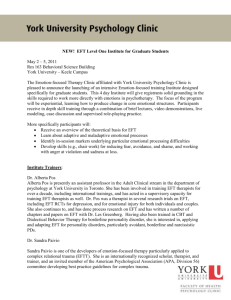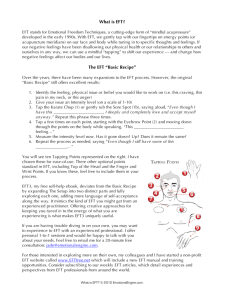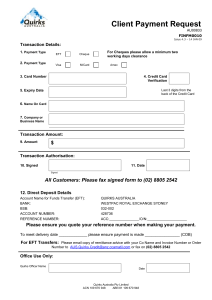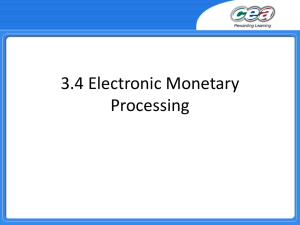Medication Administration Through Enteral Feeding Tubes
advertisement
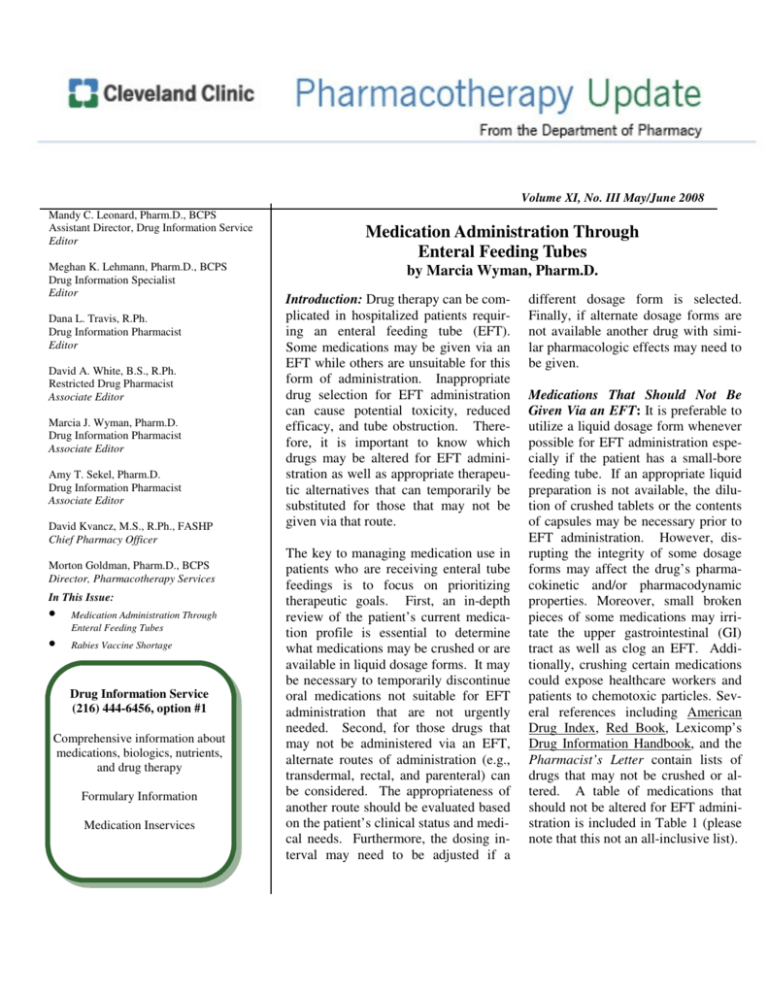
Volume XI, No. III May/June 2008 Mandy C. Leonard, Pharm.D., BCPS Assistant Director, Drug Information Service Editor Meghan K. Lehmann, Pharm.D., BCPS Drug Information Specialist Editor Dana L. Travis, R.Ph. Drug Information Pharmacist Editor David A. White, B.S., R.Ph. Restricted Drug Pharmacist Associate Editor Marcia J. Wyman, Pharm.D. Drug Information Pharmacist Associate Editor Amy T. Sekel, Pharm.D. Drug Information Pharmacist Associate Editor In this Issue David Kvancz, M.S., R.Ph., FASHP Chief Pharmacy Officer Morton Goldman, Pharm.D., BCPS Director, Pharmacotherapy Services In This Issue: • • Medication Administration Through Enteral Feeding Tubes Rabies Vaccine Shortage Drug Information Service (216) 444-6456, option #1 Comprehensive information about medications, biologics, nutrients, and drug therapy Formulary Information Medication Inservices Medication Administration Through Enteral Feeding Tubes by Marcia Wyman, Pharm.D. Introduction: Drug therapy can be complicated in hospitalized patients requiring an enteral feeding tube (EFT). Some medications may be given via an EFT while others are unsuitable for this form of administration. Inappropriate drug selection for EFT administration can cause potential toxicity, reduced efficacy, and tube obstruction. Therefore, it is important to know which drugs may be altered for EFT administration as well as appropriate therapeutic alternatives that can temporarily be substituted for those that may not be given via that route. The key to managing medication use in patients who are receiving enteral tube feedings is to focus on prioritizing therapeutic goals. First, an in-depth review of the patient’s current medication profile is essential to determine what medications may be crushed or are available in liquid dosage forms. It may be necessary to temporarily discontinue oral medications not suitable for EFT administration that are not urgently needed. Second, for those drugs that may not be administered via an EFT, alternate routes of administration (e.g., transdermal, rectal, and parenteral) can be considered. The appropriateness of another route should be evaluated based on the patient’s clinical status and medical needs. Furthermore, the dosing interval may need to be adjusted if a different dosage form is selected. Finally, if alternate dosage forms are not available another drug with similar pharmacologic effects may need to be given. Medications That Should Not Be Given Via an EFT: It is preferable to utilize a liquid dosage form whenever possible for EFT administration especially if the patient has a small-bore feeding tube. If an appropriate liquid preparation is not available, the dilution of crushed tablets or the contents of capsules may be necessary prior to EFT administration. However, disrupting the integrity of some dosage forms may affect the drug’s pharmacokinetic and/or pharmacodynamic properties. Moreover, small broken pieces of some medications may irritate the upper gastrointestinal (GI) tract as well as clog an EFT. Additionally, crushing certain medications could expose healthcare workers and patients to chemotoxic particles. Several references including American Drug Index, Red Book, Lexicomp’s Drug Information Handbook, and the Pharmacist’s Letter contain lists of drugs that may not be crushed or altered. A table of medications that should not be altered for EFT administration is included in Table 1 (please note that this not an all-inclusive list). Table 1: Common Medications That Should Not Be Crushed Generic Name Brand Name Dosage Form Sustained-release Medications Aspirin/Dipyridamole Aggrenox Tablet Bupropion Wellbutrin SR, XL, Zyban Tablet Carbamazepine Carbatrol Capsule Carbamazepine Tegretol XR Tablet Diltiazem Capsule Diltiazem Cardizem CD, Cartia XT, Dilacor XR, Diltia XT, Taztia XT, Tiazac Cardizem LA Levodopa/Carbidopa Sinemet CR Tablet Metformin Glucophage XR Tablet Methylphenidate Metadate CD, Ritalin LA Capsule Methylphenidate Tablet Metoprolol Concerta, Metadate ER, Ritalin SR Toprol XL Morphine Sulfate Avinza, Kadian Capsule Morphine Sulfate MS Contin, Oramorph SR Tablet Aspirin Enteric-Coated Medications Ecotrin Tablet Bisacodyl Dulcolax Tablet Budesonide Entocort EC Capsule Ferrous Sulfate Feosol Tablet Pancrelipase Creon, Pancrease, Ultrase MT Capsule Tablet Tablet Medications That Can Be Irritating Alendronate Fosamax Tablet Benzonatate Tessalon Perles Capsule Ganciclovir Cytovene Capsule Isotretinoin Accutane Capsule Piroxicam Feldene Capsule Temozolomide Temodar Capsule Valproic Acid Depakene Capsule Medications That Can Be Teratogenic and/or Carcinogenic Dutasteride Avodart Capsule Finasteride Propecia, Proscar Tablet Mycophenolate Cellcept Capsule/Tablet Ganciclovir Cytovene Capsule Valganciclovir Valcyte Tablet Adapted from the Pharmacist’s Letter; February 2005 Volume 22 Enteric-Coated Medications: Enteric-coated formulations are designed to pass through the stomach intact so that drug release can occur in the intestine. This dosage formulation prevents destruction of the drug by stomach acid, reduces GI irritation, and allows for a delayed onset of action. Examples of enteric-coated medications include aspirin (Ecotrin®), bisacodyl (Dulcolax®), and duloxetine (Cymbalta®). Crushing enteric-coated products could affect the drug’s efficacy as well as increase the risk of GI toxicity. Furthermore, enteric-coated formulations do not crush well and often break into small particles that may clog an EFT. Therefore, enteric-coated medications should not be administered through an EFT. Extended-Release Products: Long-acting dosage forms typically deliver their drug content over a prolonged period of time. Examples of these products include multiple-layer tablets that systematically eliminate drug as each layer is dissolved, capsules containing mixed-release pellets, and inert matrixes that slowly release drug. These formulations provide a steady drug level for 8-, 12-, or 24-hours. Crushing or breaking these products can cause an immediate release of a potentially harmful dose of medication sometimes referred to as dose dumping. Besides increasing the risk of adverse events, altering these products reduces their therapeutic benefits by producing wide variations in serum drug levels. Most long-acting drug names include an identifying abbreviation [e.g., SR (slow- release), LA (long-acting), CR (controlled-release), CRT (controlled–release tablet), SA (sustainedrelease), TD (time-delay), TR (time-release), XL (extended-length), contin (continuous-acting), and 24 (24 hour)]. Additionally, some dosage forms that contain a sustained-release mechanism include spansules, sequels, timecaps, and sprinkles. These extended-release preparations should never be crushed for EFT administration. Sublingual and Buccal Medications: Sublingual and buccal tablets are placed under the tongue or between the gum and cheek, respectively. These products are meant to dissolve quickly in the mouth for rapid absorption through a large supply of blood vessels in the oral mucosa. Drugs are often given via this route to avoid first pass metabolism. Examples of sublingual or buccal medications include nitroglycerin tablets, clotrimazole (Mycelex®) troches and buprenorphine/naloxone (Suboxone®) tablets. Administering these medications through an EFT will alter their absorption which could potentially reduce their efficacy. Irritants and Chemotoxic Agents: The alteration of some dosage forms for EFT use could increase the risk of drug-related adverse effects. It may be undesirable to administer particles of a drug that could cause ulceration of the GI tract. Some drugs that are known irritants include alendronate (Fosamax®), isotretinoin (Accutane®), and valproic acid (Depakene®). Additionally, pulverizing certain drugs can release teratogenic and/or carcinogenic particles into the air. Therefore, to prevent unnecessary chemotoxic exposure, medications such as mycophenolate (Cellcept®), valganciclovir (Valcyte®), and finasteride (Proscar®) should not be crushed for administration via an EFT. Laxatives and Medicinal Resins: Bulk-forming laxatives, such as psyllium (Metamucil®) may cause EFT obstruction. Even when properly diluted, these products form a semisolid mass that may clog an EFT. For patients with an EFT requiring fiber therapy, Benefiber®, a fiber supplement available from the CC Dietary Department, may be a better choice than psyllium since it is more soluble and can readily pass through an EFT. Additionally, bile acid sequestrants such as cholestyramine (Questran®) may also clog an EFT. In this case, other cholesterol lowering agents which are more compatible with EFT administration should be selected if the patient requires an EFT for an extended period of time. Therapeutic Alternatives: Patients with an EFT previously taking long-acting medications may need to be switched to an immediate-release preparation. When recommending an immediate-release dosage form, it is important to maintain the same total daily dosage as much as possible while keeping in mind that the dosage frequency will need to be increased. For example, an order for a long-acting theophylline product given once or twice daily may be changed to theophylline liquid given in equally divided doses every 6 hours. Likewise, three doses of phenytoin suspension given every 8 hours can be substituted for a once-daily dose of long-acting phenytoin capsules as long as the total daily dosage is maintained. Since theophylline and phenytoin both have narrow therapeutic indexes, it would be advisable to monitor serum drug levels following changes in dosage form. Additionally, orders for extended-release diltiazem preparations that are given once or twice daily may be switched to immediate-release diltiazem (Cardizem®) tablets given in equally divided doses four times daily. Special Considerations with Liquid Dosage Forms: Certain drug suspensions should not be administered down an EFT. For instance, ciprofloxacin (Cipro®) suspension should never be given through an EFT since its thick consistency could cause tube obstruction. However, immediate-release ciprofloxacin tablets may be crushed and mixed with water for EFT administration. Lansoprazole (Prevacid®) is commercially available as a packet of granules meant to be mixed with water in order to form a suspension. However, this suspension contains xanthan gum which can potentially expand in an EFT causing blockage. As part of the Cleveland Clinic’s Proton Pump Inhibitors Therapeutic Interchange, Prevacid® SoluTabs are recommended for EFT administration. Unlike the granule formulation, Prevacid® SoluTabs are evenly dispersed when diluted and should not clog an EFT. It is important to note that in most clinical situations oral disintegrating tablets such Prevacid® SoluTabs should not be given by mouth in patients with an EFT; it is preferable to dilute Prevacid® SoluTabs in an appropriate amount of water for administration via an oral syringe through an EFT. Special Considerations (continued): Many commercially available liquid preparations are hyperosmolar. Administration of large quantities of these products can cause diarrhea, cramping, abdominal distention, and vomiting. These GI-related side effects may be reduced by diluting liquid medication with at least 30 ml of sterile water prior to administration. Inactive ingredients such as sorbitol, an artificial sweetener in many syrups and suspensions, may also cause GI upset especially diarrhea. Therefore, it is important to limit the number of sorbitol-containing products as much as possible. If a liquid formulation is not commercially available, extemporaneous preparations may be manufactured. Formulas for extemporaneous products are available in several references such as Trissel’s Stability of Compounded Formulations, Extemporaneous Formulations, and Pediatric Drug Formulations. The CCPharmacy routinely compounds metronidazole (Flagyl®), amiodarone (Cordarone®), and several other suspensions. Capsules and Tablets: Many short-acting tablets may be pulverized into a fine powder and diluted with water to form a slurry appropriate for EFT administration. The contents of certain capsules may also be mixed with water to be given in a similar manner. Furthermore, the pellets inside microencapsulated medications can be flushed down an EFT following dilution as long as they are not crushed. Examples of these microencapsulated agents include ferrous gluconate (Fergon®) and verapamil (Verelan®). The liquid contents of soft gelatin capsules [e.g., acetazolamide (Diamox®) and nimodipine (Nimotop®)] may be aspirated with a needle and syringe and given through an EFT; in this case it is important to withdraw the entire contents of the capsule. In order to prevent inadvertent parenteral administration of liquid nimodipine, the CC Pharmacy prepares nimodipine (Nimotop®) oral syringes which are labeled “FOR ORAL USE ONLY.” Other Options: In some instances, the parenteral form of a drug can be used if an appropriate liquid formulation is not available. The injection may be placed in a sufficient amount of fluid such as water or juice prior to EFT administration. Prior to using an injectable drug for oral use it is necessary to make sure that there are no compatibility issues and/or significant differences in drug absorption. If a dosage form may not be altered for EFT administration, it may be necessary to use a chemically different but clinically similar drug that is either available in liquid form or may be crushed. For instance, tamsulosin (Flomax®) capsules should not be given through an EFT since they contain time-released pellets that may cause dose dumping if disrupted and/or clog the feeding tube. In this case doxazosin (Cardura®) tablets could be used as a therapeutic alternative since they may be crushed. However, doxazosin may cause a greater drop in blood pressure than tamsulosin; therefore, it important to monitor the patient carefully following conversion to doxazosin. Clogged Feeding Tubes: Medications cause obstruction in about 15% of patients receiving enteral tube feedings. To prevent clogging, viscous liquids should be diluted prior to administration. Furthermore, medications should be given separately through an EFT and flushed with 15 to 30 ml tepid of water between each dose. After medication administration, the EFT should be flushed with at least 30 ml of tepid water. There are several mechanisms for handling clogged feeding tubes. Sometimes tube blockage can be resolved by flushing with warm tap water and applying gentle pressure. Additionally, club soda can be used to break up a tube occlusion. Cranberry juice and carbonated colas or ginger ale should not be used to restore tube patency since these liquids are acidic and could actually contribute to the blockage by denaturing proteins in the enteral formulas. Papain contained in Adolph’s Meat Tenderizer is also used (mainly for adult patients) to open up a blocked feeding tube. In some cases, an alkalinized enzyme solution consisting of a crushed sodium bicarbonate tablet mixed with a crushed Viokase tablet diluted in sterile water can be used to break up medication-related occlusions. This mixture is placed into the blocked tube which is then clamped for at least 10 minutes. Afterwards the tube is flushed with water until patency is achieved. Additionally, Clog-Zapper®, which is available as a ready-to-use kit, can be ordered from the CC Storeroom to assist in unclogging an EFT. Conclusion: Drug therapy can be modified for patients requiring enteral tube feedings. Careful selection and preparation of appropriate dosage forms are essential to ensure efficacy and avoid drug toxicity and tube obstruction. In order to prevent potential drug-nutrient incompatibilities, it is important to adequately flush the feeding tube, separately administer drug doses, and not mix most medications with nutritional formulas. Utilizing the proper dosage forms along with recommended administration techniques will reduce the risk of drug-enteral feeding complications. Ask the Drug Information Center a Question Question: Is there a shortage of rabies vaccine (RabAvert® [Chiron Therapeutics] and Imovax® [Sanofi Pasteur])? Answer: Yes, there is a shortage of rabies vaccine (RabAvert® and Imovax®). Explanation: There are two manufacturers of rabies vaccine [Sanofi-Pasteur (IMOVAX®) and Novartis/Chiron (RabAvert®)]. The rabies vaccine is in short supply due to manufacturing issues and is only available for post-exposure cases. The companies have worked with the Centers for Disease Control and Prevention (CDC), the Food and Drug Administration (FDA), and the Department of Health and Human Services (DHHS) regarding this decision to only supply the vaccine for post-exposure. According to Morbidity and Mortality Weekly Report (MMWR) Guidelines, post-exposure prophylaxis for rabies is considered a medical urgency NOT a medical emergency. In the event of a rabid exposure, the wound should be adequately cleaned and rabies immunoglobulin (HyperRab® or IMOGAM®) should be administered as soon as possible to patients who have never received the vaccine since the rabies vaccine does not need to be given immediately. Patients who have received the rabies vaccine previously should not receive the rabies immunoglobulin for post-exposure care. Currently, the rabies vaccine can only be obtained for post-exposure prophylaxis. It is administered intramuscularly for five doses, recommended on days 0, 3, 7, 14, and 28. The rabies immunoglobulin should be administered as soon after exposure as possible, in patients who have never received the rabies vaccine, at a dose of 20 units/kg. Finally, because of the national shortage, rabies vaccine should not be dispensed to students, travelers, or occupational workers at high-risk (e.g., veterinarians, vet students, or lab technicians). The rabies vaccine should only be dispensed and can only be obtained for post-exposure prophylaxis. Antimicrobial Formulary Update The Antimicrobial Subcommittee met in April 2008, and the following decisions were approved by the Pharmacy and Therapeutics Committee on May 6, 2008. Formulary Additions: 1) Etavirine (IntelenceTM): A non-nucleoside reverse transcriptase inhibitor used in the treatment of HIV. The dose is 200 mg orally twice daily after meals, and the most common side effects include rash and nausea. 2) Moxifloxacin (AveloxTM): A fluoroquinolone antibiotic that is restricted to use in the Emergency Department for patients admitted with community-acquired pneumonia and documented penicillin allergies in whom ceftriaxone cannot be used (i.e., anaphylaxis to penicillin). Ciprofloxacin (Cipro®) remains the Formulary fluoroquinolone for all other indications. Restriction Changes: 1) Micafungin: Micafungin will remain restricted to the Department of Infectious Diseases. However, recent clinical data have demonstrated equivalent efficacy for 150 mg and 100 mg of micafungin in the treatment of candidemia in immunocompromised and immunocompetent hosts. The lower dose should be considered in patients with candidemias (without evidence of endocarditis, osteomyelitis) and other candidal infections. The new edition of the CC Guidelines for Antimicrobial Usage Book will be available in Fall 2008 Did You Know... Omeprazole and Clopidogrel Interaction A recently published study demonstrated a pharmacokinetic interaction between omeprazole (Prilosec®) and clopidogrel (Plavix®). When taken concomitantly, omeprazole decreases the antiplatelet response of clopidogrel. Since the study did not evaluate clinical outcomes, its clinical significance remains unknown. However, caution should be used when prescribing this combination of medications. Currently, there are no data to support that the use of a proton pump inhibitor decreases the occurrence of gastric bleeding when a patient is taking clopidogrel, and a proton pump inhibitor should not be used as the sole purpose to decrease the risk of gastric bleeding in these patients. There are circumstances where the combination may be necessary and thus, the benefits would need to outweigh the risks. Other proton pump inhibitors are cleared through the same mechanism as omeprazole, and therefore may have the same risks. Reference: Gilard M, Arnaud B, Cornily JC, Le Gal G, Lacut K, Le Calvez G, et al. Influence of omeprazole on the antiplatelet action of clopidogrel associated with aspirin. J Am Coll Cardiol 2008;51:256-60. Cleveland Clinic Department of Pharmacy/Hb-03 Drug Information Center

